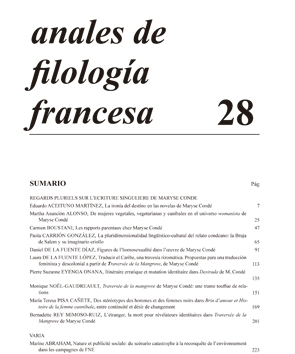From the ether to the abyss, a Balzacian journey towards the inversion of the romanesque world from two writings to the antipodes: Sarrasine and La Rabouilleuse
Supporting Agencies
- Université de Lorraine
Abstract
Balzac in his Human Comedy project designed a large-scale undertaking intended to be a reflection, if not exact, at least very faithful of the world around him. He can also, always with a realistic concern, decide to show the exact opposite of what he has revealed before. What is important in this paradoxical connection is the journey between two alleged antithetical universes. Thus this aesthetic of the path towards a reversal of potential values causes a tension between two opposite poles. However, the romantic universes are not in total opposition and the reversal may be an indication of a significant and significant change. Our examples will be taken from two works by Balzac: Buckwheat (1830) and La Rabouilleuse (1842). These two books were chosen for their points of divergence, to show the evolution of the writer’s work over time and how his journey is representative of personal enrichment and he illustrates the evolution of his aesthetic choices.
Downloads
-
Abstract379
-
PDF (Français )286
References
Andréoli (Max), « Sur l’écriture balzacienne : La Rabouilleuse. », L’Année balzacienne, n°7, 2006, pp.321-341.
Balzac (Honoré de),1842, La Rabouilleuse, Paris, Gallimard, 1972.
Balzac (Honoré de), 1832, Le Curé de Tours, Paris, Gallimard, 1976.
Balzac (Honoré de), 1830, Sarrasine, Paris, Librairie Générale française, 2001.
Barthes (Roland), S/Z, Paris, Éditions du Seuil, 1970.
Bataille (Georges),1957, Le Bleu du ciel, Paris, Flammarion, 1998.
Béguin (Albert), Balzac visionnaire, Genève, Albert Skira, 1946.
Bordas (Eric), « Sarrasine de Balzac, une poétique du contresens », Nineteenth-Century French Studies, Automne 2002-Hiver 2003, no 31, vol. 1-2, pp. 41-52.
Borowitz (Helen), « Balzac’s Sarrasine: The Sculptor as Narcissus », Nineteenth-Century French Studies, 1977, no 5, p. 171-185.
Carpenter (Scott), « Illusion et idéalisme dans la Marquise et Sarrasine, French Review, mars 2006, n°79, vol. 4, pp.749-759.
Citron (Pierre), « Interprétation de Sarrasine », L'Année balzacienne, 1972, pp. 81-95.
Citron (Pierre), « Sarrasine », L’Année balzacienne, Paris, Garnier Frères, 1966, pp. 369-370.
Citron (Pierre), « Sarrasine, Louis Lambert et Balzac », L’Année balzacienne, 1968, pp. 389-393.
Creech (James), « Castration and Desire in Sarrasine and The Girl with the Golden Eyes: A Gay Perspective », The Rhetoric of the Other: Lesbian and Gay Strategies of Resistance in French and Francophone Contexts, Martine Antle et Dominique D. Fisher, éd. et intro., New Orleans, UP of the South, 2002, pp. 45-63.
David (Henri), « Balzac italianisant : autour de Sarrasine », Revue de littérature comparée, 1933, no 13, pp. 457-468.
Didier (Béatrice), « Logique du récit musical chez Stendhal et chez Balzac », Stendhal, Balzac, Dumas. Un récit romantique ?, Editions Chantal Massol,Presses U du Mirail, 2006, pp. 137-147.
Ette (Ottmar), « Macht und Ohnmacht der Lektüre: Bild-Text-Relationen in Balzacs Novelle Sarrasine », Macht Text Geschichte: Lektüren am Rande der Akademie, Wurtzbourg, Königshausen und Neumann, 1997, pp. 36-47.
Kevelson (Roberta), « “Figures” and Semiotic Relations: A Rhetoric of Syntax in Balzac’s Sarrasine », Semiotica, 1978, no 24, pp. 113-147.
Knight (Diana), « From Painting to Sculpture: Balzac, Pygmalion and the Secret of Relief in Sarrasine and The Unknown Masterpiece », Paragraph, mars 2004, no 27, vol. 1, pp. 79-95.
Knight (Diana), Balzac and the Model of Painting, Londres, Legenda, 2007.
Kolb (Katherine), « The Tenor of Sarrasine », PMLA, Octobre 2005, no 120, vol. 5, pp. 1560-1575.
Lacan (Jacques), Ecrits, Paris, Seuil, 1966.
Miller (Jacques-Alain), Psychanalyse au miroir de Balzac, Paris, Huysmans, 2006.
Molino (Jean), « Balzac et la technique du portrait : autour de Sarrasine », Lettres et réalités, Aix-en-Provence, PU de Provence, 1988, pp. 247-83.
Pavel (Thomas), « Allusion et transparence : sur “le code culturel” de Sarrasine », Travaux de littérature, 1996, no 9, pp. 295-311.
Pavel (Thomas), « Énergie et illusion : sur les protagonistes de Sarrasine », French Forum, septembre 1996, no 21, vol. 3, pp. 301-318.
Reboul (Jean), « Sarrasine » ou la castration personnifiée, Paris, Cahiers pour l'analyse, Bibliothèque Sigmund Freud, 1967, pp.91-96.
Serres (Michel) ; L'Hermaphrodite : Sarrasine sculpteur, Paris, Flammarion, 1987.
Sprenger (Scott), « Sarrasine de Balzac ou l’archéologie du moi moderne », in La Pierre et la Plume, Nîmes, Champs social, 2008, pp. 291-318.
Tournier (Isabelle), Balzac, nouvelles et contes, Vol. 2, T.1, Paris, Gallimard, Quarto, 2005.
Las obras que se publican en esta revista están sujetas a los siguientes términos:
1. El Servicio de Publicaciones de la Universidad de Murcia (la editorial) conserva los derechos patrimoniales (copyright) de las obras publicadas, y favorece y permite la reutilización de las mismas bajo la licencia de uso indicada en el punto 2.
2. Las obras se publican en la edición electrónica de la revista bajo una licencia Creative Commons Reconocimiento-NoComercial-SinObraDerivada 3.0 España (texto legal). Se pueden copiar, usar, difundir, transmitir y exponer públicamente, siempre que: i) se cite la autoría y la fuente original de su publicación (revista, editorial y URL de la obra); ii) no se usen para fines comerciales; iii) se mencione la existencia y especificaciones de esta licencia de uso.
3. Condiciones de auto-archivo. Se permite y se anima a los autores a difundir electrónicamente las versiones pre-print (versión antes de ser evaluada) y/o post-print (versión evaluada y aceptada para su publicación) de sus obras antes de su publicación, ya que favorece su circulación y difusión más temprana y con ello un posible aumento en su citación y alcance entre la comunidad académica. Color RoMEO: verde.










